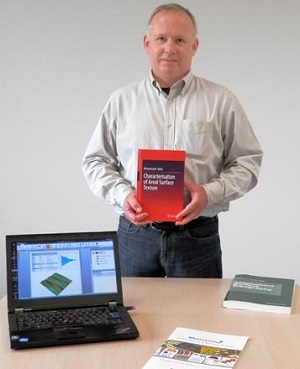François Blateyron, COO of Digital Surf, has contributed two chapters to a new book “Characterisation of Areal Surface Texture” edited by Prof. Richard Leach, Principal Research Scientist at the National Physical Laboratory in the UK.
 François Blateyron with the new book “Characterization of Areal Surface Texture” and MountainsMap software.
François Blateyron with the new book “Characterization of Areal Surface Texture” and MountainsMap software.
The book, published by Springer, presents areal characterization methods that are being adopted by the international community. These methods are used to interpret surface topography measurement data and to provide appropriate functional information for applications that range from automobile and solar cell manufacture to archaeology.
Mr. Blateyron is one of the French members of the ISO TC213 workgroup responsible for two standards: ISO 25178, the first international standard on 3D areal surface texture, and ISO 16610 which defines advanced filtration techniques. His two contributed chapters are on field parameters and feature parameters. Field parameters (for example Sa, Sz, Sdq) are calculated using every data point in the evaluation area and, for example, make it possible to characterize surface heights, slopes, complexity and wavelength content. Feature parameters (for example S10z, Spc) only take into account specific points, lines or areas. Features are considered because of their functional role in specific applications: for example, large peaks and hills have a functional role as contact zones in mechanical engineering.
The two chapters include historical background information, a description of the underlying concepts, and a detailed account of the field and feature parameters defined in ISO 25178. These parameters are implemented in MountainsMap® metrology software by Digital Surf.
Other chapters in the book cover areal filtering methods, areal form removal, areal fractal methods, choosing the appropriate parameter, the characterization of individual areal features, and the multi-scale signature of surface topography. Applications that are discussed include solar cell efficiency, motor cylinder honing techniques, glass plating, inspection of laser structured cams and conrods, and road surfaces.
“Thanks to the contributions from the authors, all experts in their fields, this new book on the characterization of areal surface texture presents methods that are being adopted by the international metrology community, together with a selection of highly pertinent applications with significant impact on our environment and our everyday lives,” stated Professor Richard Leach, Principal Research Scientist at the National Physical Laboratory in the UK and editor of the new book.